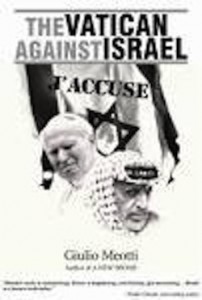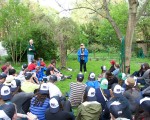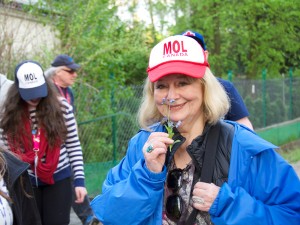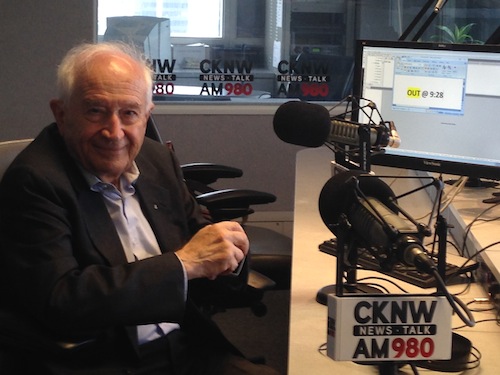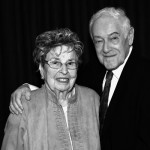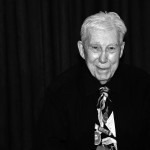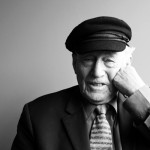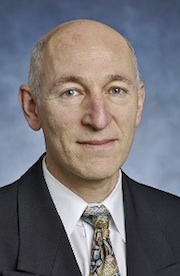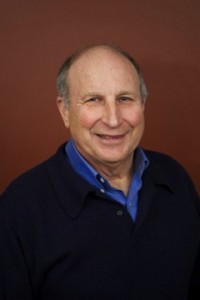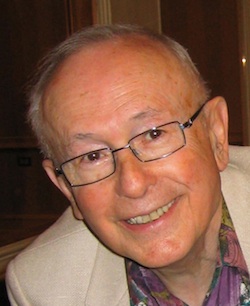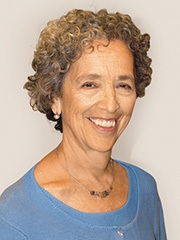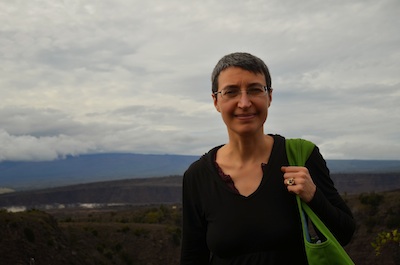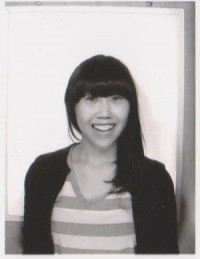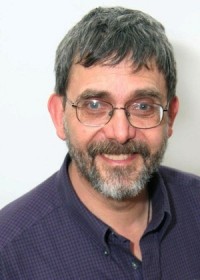The tuna salad recipe is one of Lynn Kirsche Shapiro’s mother’s most popular recipes. (photo by Nick Ulivieri Photography)
The first section of Food, Family and Tradition: Hungarian Kosher Family Recipes and Remembrances (Cherry Press, 2013) is a family album, which Lynn Kirsche Shapiro says is her way of completing two unfinished legacies: “my mother’s recipes and my father’s autobiography.”
Her mother went blind at age 75 and Shapiro viewed the project of compiling her recipes as a tangible tribute to her mother’s contribution to the lives of her family and others. Her father was in the process of writing his life story when he died at the age of 81.
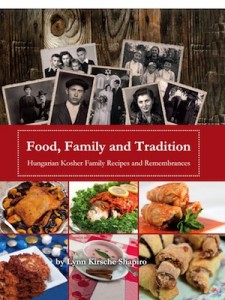
“After beginning the book, I understood that my family’s recipes and history were part of a larger world: the traditional Jewish life in Czechoslovakia and Hungary before the Holocaust,” Shapiro writes. “Many books have been written to educate others, to bear witness to the events and atrocities of the Holocaust. My book also attempts to get the picture of the richness of Jewish life in Eastern Europe prior to the Holocaust. Strong family traditions were the bedrock on which our parents, and so many of the Holocaust survivors, were raised. It is because of this strong family bond, deep tradition and unwavering faith that our parents were able to live again, to build a family and to contribute to the future.”
Shapiro’s father, Sandor Kirsche (Shalom Kirschenbaum) was born in a village in Carpathian Czechoslovakia. His family ran a small grocery store in their home. Barely surviving Buchenwald, he returned to his hometown of Hlyuboka, where he found his remaining two sisters who, along with Sandor and an aunt and uncle, were the only five remaining from 38 family members. A ship he had planned to take to Palestine was canceled and he soon after met Margit Weisz. They married in 1947 and moved to Chicago. There, Sandor worked in retail foods and, in 1973, opened an all-kosher supermarket that thrives today.
Margit was born in Gergely, Hungary. In 1944, on the last day of Passover, word came that the Nazis were to evacuate the Jews the next day. Her family hired non-Jews to drive them in wagons away in the night, but they were caught. They were sent first to a ghetto and then most of the family was killed in Auschwitz. Shapiro’s mother was sent to a subcamp of Buchenwald, where she worked with 250 other women preparing wooden crates and making ammunition. After liberation, she discovered that a brother had survived, alone among their large family. Meeting Sandor shortly after liberation, the family story takes an uplifting turn as their American dream becomes real.
The recipes in the book are not really innovative. Many of them, like the ones included here, which have been proven in one of the Jewish Independent “test kitchens,” are superb in part because of their simplicity. While East European cuisine generally, and its Jewish form specifically, certainly have dishes that are set apart from others as emblematic of major celebrations, they emphatically avoid fancy-schmancy trends so common today. This is probably why recipes like these last generations.
The book, in fact, has a litany of the classics of Ashkenazi Jewish cuisine: chopped chicken liver, gefilte fish, chopped herring, stuffed cabbage, borscht, potato soup, chicken soup, of course, blintzes, kugel, boiled fish, schmaltz, cholent, goulash, brisket, tzimmes, beet salad, latkes, kasha, and a litany of baking from challah to dumplings and honey cake.
While these recipes are fitting for the High Holidays, you might want to put them aside (the ones with oil, at least) for Chanukah as well.
SWEET AND SOUR CABBAGE SOUP WITH MEAT
Traditional Hungarians cooked cabbage in a variety of ways. Here is a rich and tasty sweet and sour cabbage soup, with the deep flavor of meat. I like to cook it for a few hours to develop a flavor. For a sweeter taste, add raisins. I always do.
1 to 2 tbsp vegetable oil
1 1/2 to 2 lbs short ribs, cut into large chunks
1 medium onion, diced
1 medium head cabbage, cored, cut into small squares or shredded
1 (28-ounce) can whole tomatoes quartered or one (28-ounce) can diced tomatoes
1 cup tomato sauce
1/2 tbsp lemon juice
1/3 cup sugar
1/4 tsp freshly ground black pepper
1 tsp salt
1/3 cup dark or golden raisins, optional
In an eight-quart pot over medium-high heat, heat oil. Brown short ribs with onions, turning so ribs brown on all sides. Decrease heat to low, cover tightly and steam until meat is tender, about 30 minutes to one hour.
Add the cabbage, the tomatoes together with their juice, and the remainder of ingredients to the meat, including raisins if using. Add six cups of water. Bring to a boil, decrease heat to low and simmer, covered, until the cabbage and the meat are both tender, about one hour. Taste and adjust seasonings. For a richer flavor, cook an additional 30 minutes to one hour.
Serve ladled into heated bowls. Makes eight to 10 (eight-ounce) servings.
TUNA SALAD
This tuna salad is one of my mother’s most popular recipes, and we have been told that nobody’s tuna salad is as tasty. It is simple but it has its secrets. One is the grated egg; another is the oil-packed tuna. You can substitute water-packed tuna if you want a lighter salad, but the depth of flavor will not be quite the same.
1 (12-ounce) can or 2 (5-ounce) cans oil packed tuna, well-drained
3 hard-boiled eggs, shelled
1/4 cup minced onion
1 stalk celery, very finely chopped
1/3 to 1/2 cup mayonnaise
Place tuna in a medium bowl and mash with a fork. Grate the egg and add to the tuna, stirring to mix. Add the onion and celery, and mix well with the mayonnaise. Cover and refrigerate for up to three days. Makes four servings.
CHICKEN SCHNITZEL
Schnitzel is authentically European, whether veal or chicken. My mother’s chicken schnitzel is special. She debones her own white meat from the chicken, then slices it thin and pounds it to about 1/4-inch uniform thickness. Also, she uses fresh breadcrumbs for the breading. Pounding the chicken breasts uniformly thin allows them to cook faster and more evenly. For added flavor, I often mix breadcrumbs with cornflake crumbs, half and half.
6 to 8 boneless skinless chicken breast halves, about 2 pounds
1 cup flour
1 tsp seasoned salt
1/2 tsp sweet Hungarian paprika
1/4 tsp garlic powder
1/4 tsp freshly ground pepper
2 eggs, beaten, mixed with 1 tbsp water
1 cup fresh breadcrumbs, or 1/2 cup fresh breadcrumbs and 1/2 cup cornflake crumbs
vegetable oil for frying, as needed
Slice each chicken breast in half horizontally. Cover each piece with plastic wrap. Using a meat mallet or rolling pin, pound chicken breasts to an even thickness of 1/4 inch. Some tears are OK; even thickness is the most important step.
Place flour and seasonings in one shallow bowl; stir to mix. Place egg and crumbs into additional separate shallow bowls.
Dip each chicken piece first in flour, then egg and then the crumb mixture. Transfer to a tray or plate and repeat until all chicken is breaded.
In a 12-inch skillet over medium-high heat, heat oil as needed. Fry schnitzel on each side, in batches, turning once, until golden brown and cooked through, about five minutes for each side.
Serve immediately or transfer to a parchment-lined baking pan and keep warm in a 250°F oven. Serve on individual plates with vegetables and potatoes or rice of choice. Makes eight servings.
FRIED CAULIFLOWER
This is crispy and best prepared in a deep fryer. For a lighter, healthier choice, oven bake it on a cookie sheet.
oil, as needed, for deep frying
1 cup bread crumbs, preferably from challah, or 1 cup cornflake crumbs [the Independent used Panko, with great results]
1/4 tsp salt
1/4 tsp sweet Hungarian paprika
1/8 tsp freshly ground black pepper
1 cup flour
2 eggs, beaten
1 large head cauliflower, separated into florets
If frying, preheat the oil to 350°F in a deep fryer or deep pot. Season breadcrumbs or cornflake crumbs with the salt, paprika and pepper.
In three separate shallow dishes, place flour, eggs and crumbs.
Dip the cauliflower florets first in the flour, next the eggs, and then the breadcrumbs. Fry in batches in the deep fryer, drain on paper towels.
Alternatively, preheat oven to 400°F. Place breaded cauliflower florets on a parchment paper-lined baking sheet sprayed with nonstick cooking spray, and bake until crisp and brown, about 20 minutes, turning the pan once in oven.
Makes eight servings.
CUCUMBER SALAD, UKORKASALATA
Cucumbers were readily available in Hungary and Czechoslovakia from spring through summer, making ukorkasaláta a classic salad during the season, light and refreshing, perfect for a summer meal. My husband, Irv, likes to serve it as an accompaniment to grilled steak; it balances the richness of the beef. The vinegar and the salt are preservatives, allowing the salad to keep, refrigerated, for a week. Of course, as my mother says, “At home, we never worried about the refrigeration because it never lasted too long – it was all eaten up quickly.” It is best prepared in advance, so the cucumbers have a slightly pickled flavored.
2 large seedless cucumbers (about 1 1/2 pounds), skin on, sliced paper thin
one medium onion, sliced paper thin
1 heaping tbsp salt
1/3 cup water
1/3 cup sugar
1/3 cup white vinegar
Place the cucumbers and the onions in a medium bowl and toss with the salt. Let stand for one hour. Transfer to a colander and drain. Place plastic wrap on top and press down to extract the maximum liquid. Transfer drained cucumber onion mixture to a nonreactive bowl. Reserve.
In a small bowl, place water, sugar and vinegar, and whisk to dissolve sugar. Pour this marinade over the cucumber and onions. Cover and refrigerate, for up to one week.
Makes about one quart, eight servings.
Pat Johnson is a Vancouver writer and principal in PRsuasiveMedia.com.


